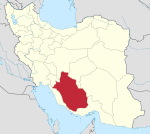world.wikisort.org - Iran
Darab (Persian: داراب, romanized: Dārāb)[2] — formerly Darabkert, or Darábgerd ("city of Darius")— is a city and capital of Darab County, Fars Province, Iran. At the 2006 census, its population was 54,513, in 13,279 families.[3]
Darab
داراب | |
|---|---|
City | |
 Darab at sunset | |
 Darab | |
| Coordinates: 28°45′07″N 54°32′40″E | |
| Country | Iran |
| Province | Fars |
| County | Darab |
| Bakhsh | Central |
| Population (2016 Census) | |
| • Total | 70,232 [1] |
| Time zone | UTC+3:30 (IRST) |
| • Summer (DST) | UTC+4:30 (IRDT) |
Historical background
Darab is one of the oldest cities in Iran, and is mentioned in the Persian epic Shahname by Ferdowsi. Legend ascribes the foundation of the city to Darius I, hence its earlier name Daráb-gerd (Darius-town).[4]
In the neighborhood there are various remains, including the Kalah i Daráb (citadel of Darius), which consists of a series of earthworks arranged in a circle around an isolated rock. Another monument in the vicinity is a giant bas-relief, carved on the vertical face of a rock, representing the victory of the Sasanian king Shapur I over the Roman emperor Valerian in 260 A.D.[4]
According to Hamza al-Isfahani, the city was triangular in design, and the circular defensive wall, which has been uncovered, was built in the 8th century by a governor of Fars under Hajjaj ibn Yusuf. The circle is irregular, and about 1,900 m in diameter.[5]
During most of the Middle Ages, the city remained the capital of a large district. The city's products included textiles, jasmine oil, various mineral salts, and mumiya, a mineral exudate.[5]
Climate
| Climate data for Darab | |||||||||||||
|---|---|---|---|---|---|---|---|---|---|---|---|---|---|
| Month | Jan | Feb | Mar | Apr | May | Jun | Jul | Aug | Sep | Oct | Nov | Dec | Year |
| Average high °C (°F) | 15.9 (60.6) |
17.4 (63.3) |
22.2 (72.0) |
25.8 (78.4) |
33.0 (91.4) |
36.3 (97.3) |
37.8 (100.0) |
37.0 (98.6) |
34.0 (93.2) |
29.8 (85.6) |
22.8 (73.0) |
18. (64) |
27.5 (81.5) |
| Average low °C (°F) | 3.4 (38.1) |
5.0 (41.0) |
8.7 (47.7) |
12.4 (54.3) |
17.8 (64.0) |
21.0 (69.8) |
23.4 (74.1) |
22.4 (72.3) |
18.7 (65.7) |
14.2 (57.6) |
8.3 (46.9) |
4.4 (39.9) |
13.3 (56.0) |
| Average precipitation mm (inches) | 48 (1.9) |
44 (1.7) |
14 (0.6) |
23 (0.9) |
1 (0.0) |
0 (0) |
1 (0.0) |
1 (0.0) |
0 (0) |
2 (0.1) |
12 (0.5) |
29 (1.1) |
175 (6.8) |
| Source: Climate-Data.org[6] | |||||||||||||
Agricultural products
Major city products are wheat, citrus, cotton, maize and palm.
Higher education
The city has five universities: Islamic Azad University, Darab Branch; Payame Noor University, Darab center; agriculture and national resources school of Darab; Paramedical school of Darab; and a branch of the Technical and Vocational University.[7]
In literature
In the notes to his long mystical poem The Kasidah (1880), Sir Richard Francis Burton describes his alter ego "Haji Abdu El-Yezdi" as being a native of Darab.
References
- "Statistical Center of Iran > Home".
- Darab can be found at GEOnet Names Server, at this link, by opening the Advanced Search box, entering "-3059243" in the "Unique Feature Id" form, and clicking on "Search Database".
- "Census of the Islamic Republic of Iran, 1385 (2006)" (Excel). Statistical Center of Iran. Archived from the original on 2011-11-11.
- One or more of the preceding sentences incorporates text from a publication now in the public domain: Chisholm, Hugh, ed. (1911). "Daráb". Encyclopædia Britannica. Vol. 7 (11th ed.). Cambridge University Press. p. 826.
- Huff, Dietrich. "DĀRĀB (2)". Encyclopaedia Iranica. Retrieved 8 July 2019.
- "Climate: Darab". Retrieved 2020-04-14.
- "Islamic Azad university of Darab". Retrieved 8 April 2020.
На других языках
[de] Dārāb
Dārāb (persisch داراب) ist eine der Städte der Provinz Fars und des Stadtzentrums von Darab. Darab liegt in der südöstlichen Provinz Fars in Iran mit seiner langen Geschichte. Die Entfernung von Darab nach Shiraz beträgt 245 km. Die Städte Neyriz, Fasa, Estahban, Dschahrom, Zarin Dascht und Larestan sind Nachbarn und ähneln Sirdschan, der Provinz Kerman und der Provinz Hormozgan.- [en] Darab
[ru] Дараб (Фарс)
Дара́б[1] (перс. داراب) — город на юге Ирана, в провинции Фарс. Административный центр шахрестана Дараб. Седьмой по численности населения город провинции[2].Другой контент может иметь иную лицензию. Перед использованием материалов сайта WikiSort.org внимательно изучите правила лицензирования конкретных элементов наполнения сайта.
WikiSort.org - проект по пересортировке и дополнению контента Википедии
